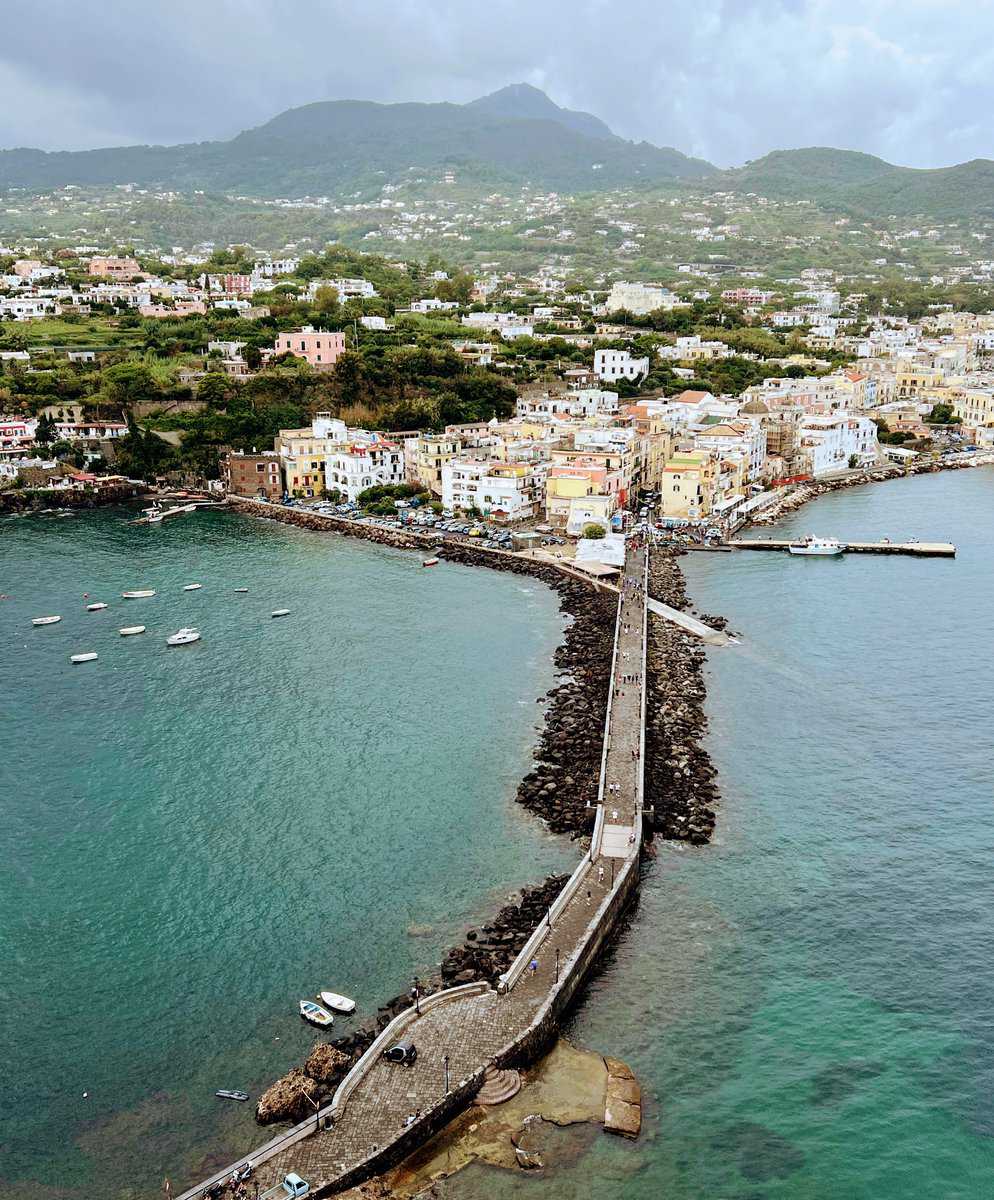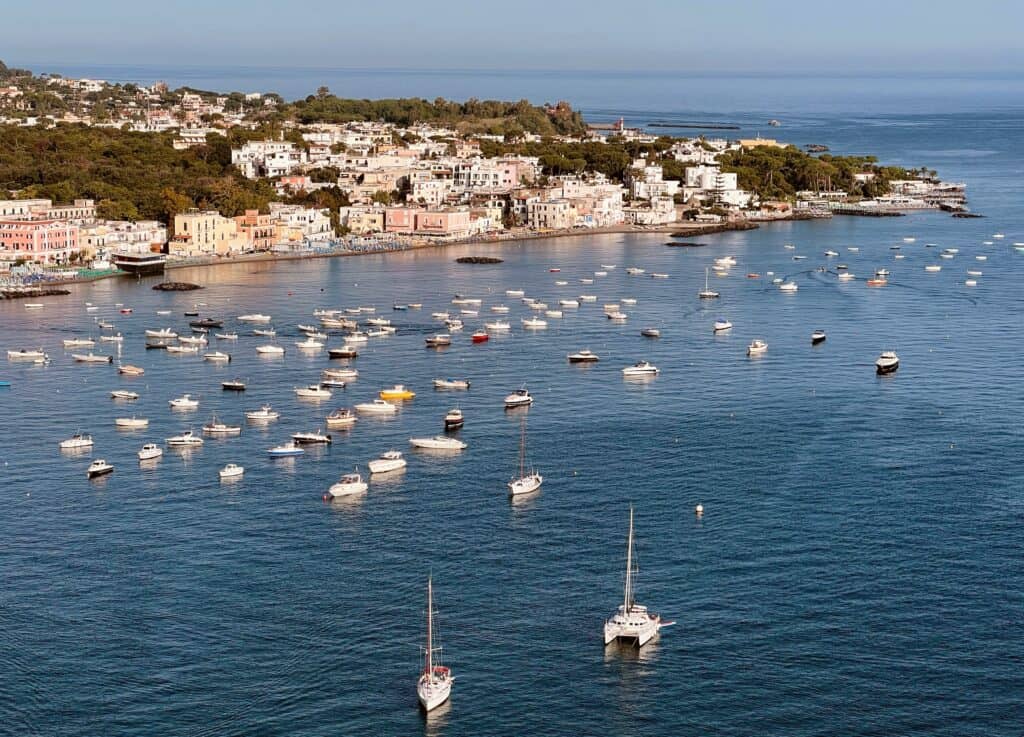Staying in Ischia’s Castello Aragonese
Out on the furthest reaches of the Bay of Naples, a miniature island surges out of the sea. Ancient temples and olive groves mingle with a medieval fortress while ruined churches serve as modern art galleries. Across a strip of water lies the larger island of Ischia, where volcanic green mountains sprout pastel buildings at the water’s edge.
Named after its 15th-century castle, the Castello Aragonese connects to Ischia via a causeway. Along with structures spanning two and a half thousand years, the islet offers a celebrated restaurant and several cafés, as well as a monastery converted into a small hotel. Although the castle makes a dreamy day trip, staying overnight allows access to countless gardens and terraces with views fit for angels.

We arrived on Ischia in jittery condition after a whirlwind, jetlagged stay in Naples. Besides providing an easy base for visiting the island’s famed spas and beaches, the Castello Aragonese gave us a glimpse of Arcadia. After three nights in the monastery, we felt positively beatific.
Castello Aragonese
Fortress & Community
Ancient Greeks established their first Italian colony on the island of Ischia, and some of the castle’s defensive structures date to 475 BCE. Looking at the islet from shore, it’s easy to see why it made an ideal fortress: this 300,000 year-old magma bubble rises almost vertically from the water. Originally, it was connected to the main island by a spur of land, but a volcanic eruption in the second century caused the soil to sink.

Less obvious from afar is the islet’s capacity to sustain an entire community. The fortress became a refuge for the region’s inhabitants in the stream of invasions following the Roman Empire’s collapse. Attacks from pirates were an ever-present threat, along with eruptions from the now-dormant volcano. At one point, the tiny island hosted 1,892 families along with several religious orders and a garrison for the prince. In 1441, the Aragonese king of Naples remodeled the castle, cutting tunnels underneath to provide better access to the structures above and adding the causeway we see today.
From Prison to Monument
English shelled the islet during the Napoleonic Wars and destroyed many of its structures. By 1823, only about 30 inhabitants remained when King Ferdinand of Naples turned the castle into a prison. After the unification of Italy prompted the closure of the complex, the Castello Aragonese was more or less abandoned.

A lawyer named Nicola Mattera purchased the fortress and surrounding property from the Italian government in 1912. Fifty-five years later, the castle was declared a national monument. In the following decades, Mattera’s artist son Gabriele and his family completed most of the restorations. Today the family continues to live on and maintain the island.
The Castello Aragonese Today

Tickets to the Castello Aragonese include a printed guide to its monuments and attractions, arranged by a numbered route winding around the islet. Visitors can expect to spend at least a few leisurely hours touring the complex. Besides the fortress and monastery, churches and other structures perch between gardens. Some retain their original interiors, while others exist as suggestive shells. Most of the buildings and terraces contain art, from 700 year-old frescoes to sculptures and paintings by Gabriele Mattera and other contemporary artists.


Our favorite spot was the terrace holding the ruins of the Cathedral of the Assumption. Built by the people of Ischia after a volcanic eruption in 1301 destroyed the existing cathedral, the church went through several stylistic phases before succumbing to shelling in 1809.

Today arches frame a central space open to the sky. In the nave, Baroque flourishes and raw bricks bask in the sun, flanked by chapels with offerings of flowers. In one alcove, a concave ceiling medallion sits on the ground like a colossal bowl, mirroring the dome still in place above it. Nearby, a statue marks steps leading to a crypt with frescoes from the school of Giotto.


Amongst the idyllic views and tranquil terraces, the island holds a few darker attractions. Besides the prison, a medieval museum features a collection of armor, weapons, and torture instruments.
Strangest of all, the nuns who once lived in this paradisical setting developed a gruesome practice. In the crypt beneath the Church of the Immaculate Conception, they propped their dead up on stone chairs with drainage holes in the seat. The nuns expressed their disdain of the human body as a receptacle for the spirit rather paradoxically, by collecting the decomposing bodies’ fluids and bones. Needless to say, the hours spent in prayer within the poorly-ventilated space probably hastened everyone’s demise.
Visiting the Castello Aragonese
The Castello Aragonese is open daily from 9 to sunset. Tickets for self-guided tours cost €12. For more information on the island, including the restaurant, art exhibits, and special events, check the Castello website and also the Friends of Gabriele Mattera Foundation.

The converted monastery, Il Monastero, is open for guests from April through October. Our room featured an arched ceiling and patterned blue-and-white tile floors. Breakfast on the terrace overlooking the sea included produce straight from the garden and exquisite morning cakes, courtesy of pastry chef Martina.
Ischia Ponte & Environs

The little town of Ischia Ponte makes an excellent base. Several sandy beaches, including the Spiaggia dei Pescatori (Fishermans’ Beach), offer views of the Castello Aragonese. We also enjoyed swimming right off the rocks lining the causeway. Plenty of restaurants offer dining both on and off the water. We liked the old-school Pizzeria Pirozzi, with its rooftop terrace overlooking the sea. (Via Seminario, 51/53.)
Getting to the Castello Aragonese
Ferries from Naples, Procida, Capri, and the Amalfi Coast stop in the nearby town of Ischia Porto. From the terminal, visitors can take a taxi or bus to Ischia Ponte and the Castello Aragonese. Taxis take about 10 minutes. Alternatively, the #7 bus departs from the station just behind the harbor; the ride takes about 15 minutes. The bus goes to the Piazzale Aragonese at the end of the causeway. During midday, however, it might not go past the intersection of Via Seminario and Via Pontano. Our Google map shows both spots. For more information on the island’s bus system, see our post on Ischia’s highlights.
Further Reading
For more on the area, see our other posts:
Amalfi Coast: Atrani and Vietri sul Mare

